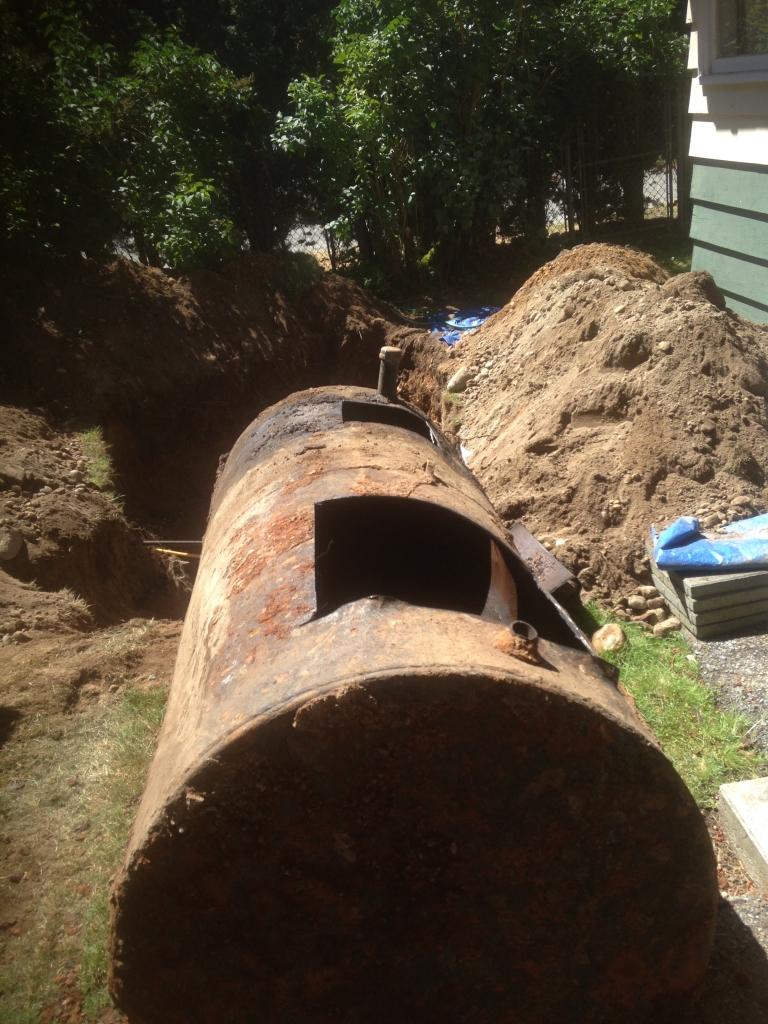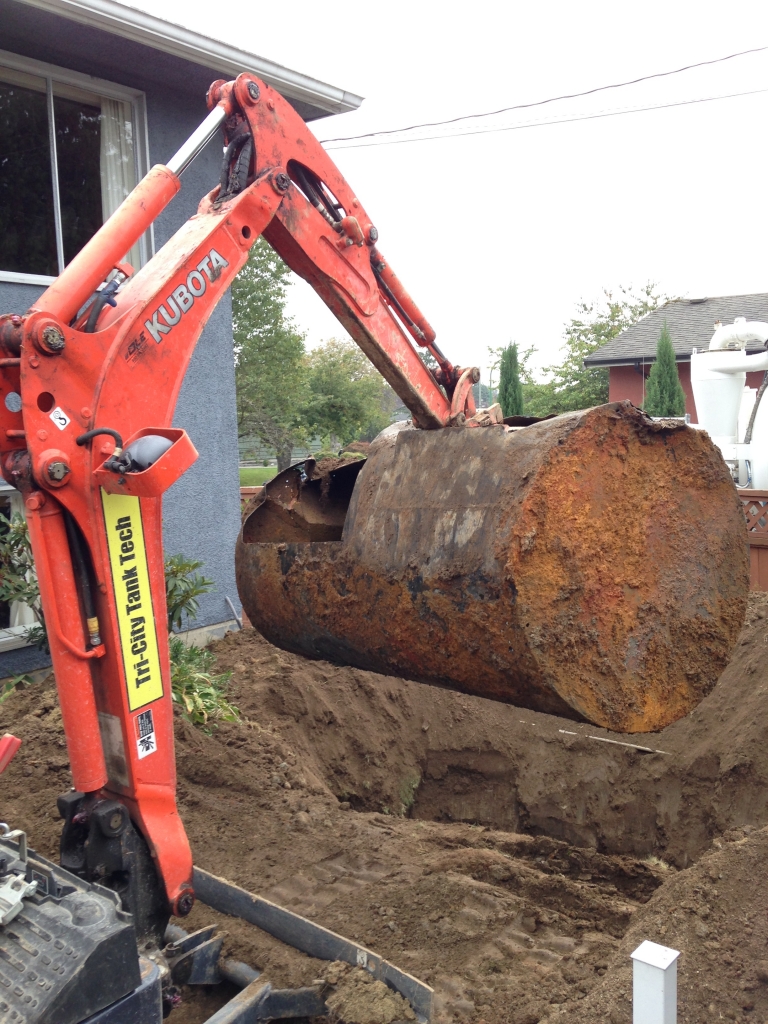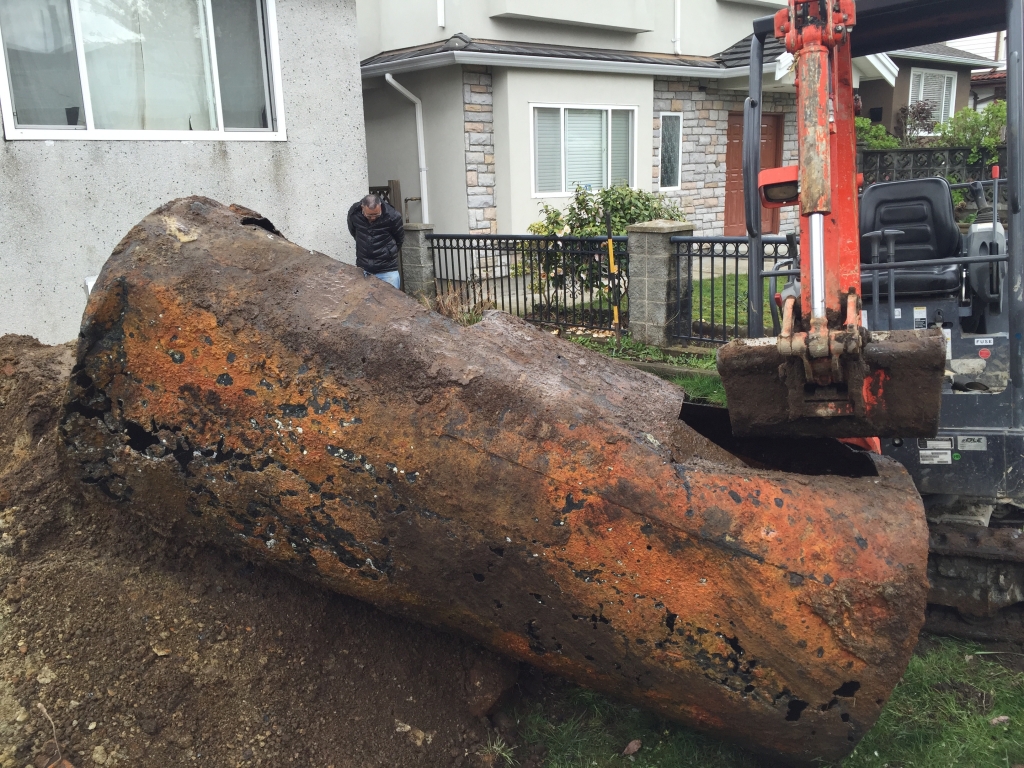What is an Oil Tank?
Before 1975, oil tanks were regularly relied upon as a fuel source for heating homes or used as a fuel source for back up generators in larger commercial buildings. For examples, please visit our gallery and check out our many pictures of oil tank removals with a shovel or by an excavator.

Why Should I Remove my Oil Tank?
There is a wide range of reasons why a homeowner would remove an Underground Storage Tank from their property. According to the BC Fire code section 4.10.3, it states that “Property owners are required to remove underground storage tanks, and all associated pipe connectors, that have been out of service for at least two years”.
Some other common reasons to remove an oil tank are:
- Property is for sale
- Renewing mortgage
- Renewing home insurance
- Complying with local government regulations
- Preparing for a renovation, eg. Building a new deck, coach house or addition.
- Being pro active
- Reducing, preventing, or mitigating any risk of potential leakage from your oil tank.
What is the age range of homes that typically have a higher probability of having a tank?
Chronologically, the most at risk properties are any home that was built before 1975. The farther you migrate from Vancouver, the later that natural gas was implement within the cities infrastructure.
Residential Underground Storage Tank Removal (RUST)

Increasingly in the past decade, the removal of residential underground storage tanks in BC has become an important topic to homeowners. In an profession that is fairly new amongst the trade sector, there is still a lot of confusion surrounding the industry. At Tri City Tank Tech it is important that we give our clients as much information as possible about the industry so they can make an educated and informed decision.
For examples, please visit our gallery and check out our many pictures of oil tank removals with a shovel or by an excavator.
How Much Does a Standard Oil Tank Removal Cost?
As every property is unique, so are the costs involved in the removal of an oil tank. There are many contributing factors that determine the cost of an underground storage tank removal, such as:
- Accessibility
- Utility obstructions (overhead and underground)
- Structural obstructions (decks, and additions)
A standard oil tank removal with no contamination on the property typically ranges from $1275 – $1675. Many times there is no access to the tank itself, so it is usually hard to determine the exact total amount of contents in the tank. Dependent on your local cities regulations there may be additional costs to consider, such as: permit, and sampling.
What is the Average Life Expectancy of an Oil Tank?
It is said that most tanks were given a life expectancy of 20-25 years; however, all tanks are not created equally and they all come in different thickness, and sizes. Plus there are many other determining factors that can affect the life of an oil tank, such as: water tables, and quality of the tank.
How Long Does a Standard Oil Tank Removal Take?
We can expose, pump, flush and extract most oil tanks in 1 day. Usually we start around 7:30-8:00am and are completed by 1:00-2:00 pm.
How Quickly Can You Start Excavating the Oil Tank?
We understand that timing is important in our industry and we do everything we can to get to your property within 1-2 days of signing the quotation.
What Are the Steps For an Oil Tank Removal?
- First, we obtain all of the necessary permits
- Next, we arrange and synchronize all contractors involved, for example: Vacuum trucks, Environmental consultants, Fire Wardens etc
- Then we excavate, pump, and remove the tank from the ground.
- Finally, samples are taken from the excavation and are submitted to the lab for analysis.
How Often Do Oil Tanks Leak?
Unfortunately this question is not as simple as it may seem. Some companies may try to give you a percentage of tanks that leak; however, they are purely throwing out numbers, as it is impossible to truly give an accurate answer. There are many contributing factors when it comes to leaking tanks and all are individually specific to each unique situation, for example:
- How high is your water table?
- How thick is your tank?
- Was your tank coated or insulated?
The answer we always give to our clients is that all tanks, and properties are different. Sometimes we will get a couple tanks that haven’t leaked in succession and sometimes we will get just the opposite. Even if we gave a ratio from our experience of tank removals, it would be totally different from a competitor’s number, as each tank has its own history.
Why Do Oil Tanks Leak?
Unfortunately there are many contributing factors that cause oil tanks to leak and they are mainly attributed to corrosion, for example:
- Atmospheric environmental corrosion: the oxygen from inside of the oil tank causes condensation on the inner walls. The water molecules drip down the inner walls of the oil tank and settle on the base of the oil tank. The collection of water on the bottom of the oil tank causes corrosion to the base of the oil tank.
- The water present in the heating oil combing with sulphur and becomes corrosive.
- Some bacteria can thrive inside of an oil tank at the point where the oil meets the water. The bacteria digests organic materials inside of the oil tank and excrete acids. This corrosive activity is usually the cause of the “tide lines” inside of the tank and can attribute to corrosion on the sides of the oil tank.
- Water ingress causes corrosion of the tank and adds more water into the atmospheric environmental cycle.
- Lack of cathodic protection and protective coatings and linings
- High water tables continuously passing the oil tank can corrode the outside shell of the tank and is one of the main factors of water ingress.
- Rainwater can flow down the outer shell (sides) of the tank, causing water to collect beneath the oil tank. This situation can lead to corrosion of the base of the oil tank.
- Loose connections of pipage, eg. filler pipe and feeder lines.
- Poor craftsmanship, for example: poorly welded seams, thin tanks, loose connections
- Spillage that occurred during the original fueling process. This can be a source of contamination around the tank, even though it is not technically cause by the tank leaking.

Do You Offer a Seniors Discount?
Yes, we happily offer no tax to our valued senior customers on our residential underground storage tank removal cost.
